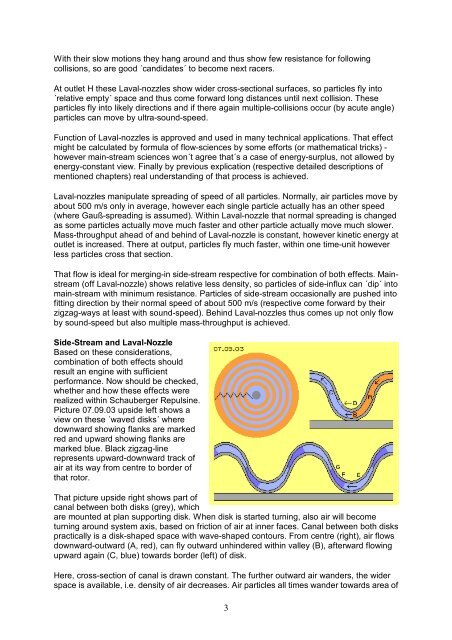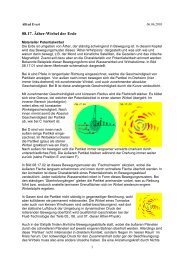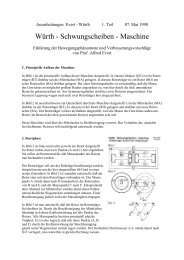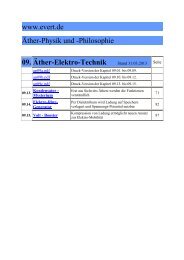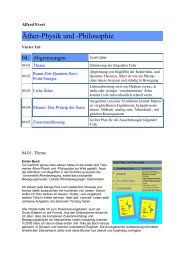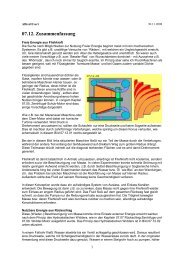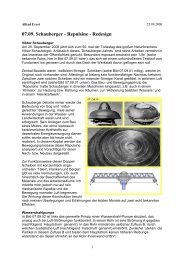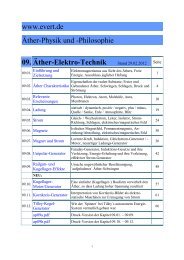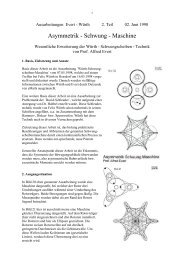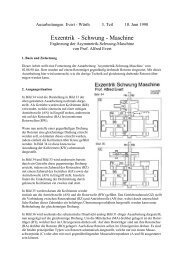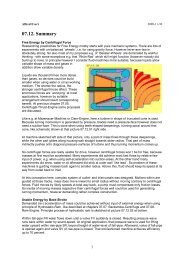07.09. Schauberger - Repulsine - Redesign - Rotor
07.09. Schauberger - Repulsine - Redesign - Rotor
07.09. Schauberger - Repulsine - Redesign - Rotor
Create successful ePaper yourself
Turn your PDF publications into a flip-book with our unique Google optimized e-Paper software.
With their slow motions they hang around and thus show few resistance for following<br />
collisions, so are good ´candidates´ to become next racers.<br />
At outlet H these Laval-nozzles show wider cross-sectional surfaces, so particles fly into<br />
´relative empty´ space and thus come forward long distances until next collision. These<br />
particles fly into likely directions and if there again multiple-collisions occur (by acute angle)<br />
particles can move by ultra-sound-speed.<br />
Function of Laval-nozzles is approved and used in many technical applications. That effect<br />
might be calculated by formula of flow-sciences by some efforts (or mathematical tricks) -<br />
however main-stream sciences won´t agree that´s a case of energy-surplus, not allowed by<br />
energy-constant view. Finally by previous explication (respective detailed descriptions of<br />
mentioned chapters) real understanding of that process is achieved.<br />
Laval-nozzles manipulate spreading of speed of all particles. Normally, air particles move by<br />
about 500 m/s only in average, however each single particle actually has an other speed<br />
(where Gauß-spreading is assumed). Within Laval-nozzle that normal spreading is changed<br />
as some particles actually move much faster and other particle actually move much slower.<br />
Mass-throughput ahead of and behind of Laval-nozzle is constant, however kinetic energy at<br />
outlet is increased. There at output, particles fly much faster, within one time-unit however<br />
less particles cross that section.<br />
That flow is ideal for merging-in side-stream respective for combination of both effects. Mainstream<br />
(off Laval-nozzle) shows relative less density, so particles of side-influx can ´dip´ into<br />
main-stream with minimum resistance. Particles of side-stream occasionally are pushed into<br />
fitting direction by their normal speed of about 500 m/s (respective come forward by their<br />
zigzag-ways at least with sound-speed). Behind Laval-nozzles thus comes up not only flow<br />
by sound-speed but also multiple mass-throughput is achieved.<br />
Side-Stream and Laval-Nozzle<br />
Based on these considerations,<br />
combination of both effects should<br />
result an engine with sufficient<br />
performance. Now should be checked,<br />
whether and how these effects were<br />
realized within <strong>Schauberger</strong> <strong>Repulsine</strong>.<br />
Picture <strong>07.09.</strong>03 upside left shows a<br />
view on these ´waved disks´ where<br />
downward showing flanks are marked<br />
red and upward showing flanks are<br />
marked blue. Black zigzag-line<br />
represents upward-downward track of<br />
air at its way from centre to border of<br />
that rotor.<br />
That picture upside right shows part of<br />
canal between both disks (grey), which<br />
are mounted at plan supporting disk. When disk is started turning, also air will become<br />
turning around system axis, based on friction of air at inner faces. Canal between both disks<br />
practically is a disk-shaped space with wave-shaped contours. From centre (right), air flows<br />
downward-outward (A, red), can fly outward unhindered within valley (B), afterward flowing<br />
upward again (C, blue) towards border (left) of disk.<br />
Here, cross-section of canal is drawn constant. The further outward air wanders, the wider<br />
space is available, i.e. density of air decreases. Air particles all times wander towards area of<br />
3


